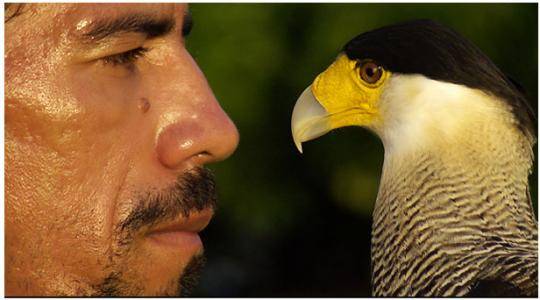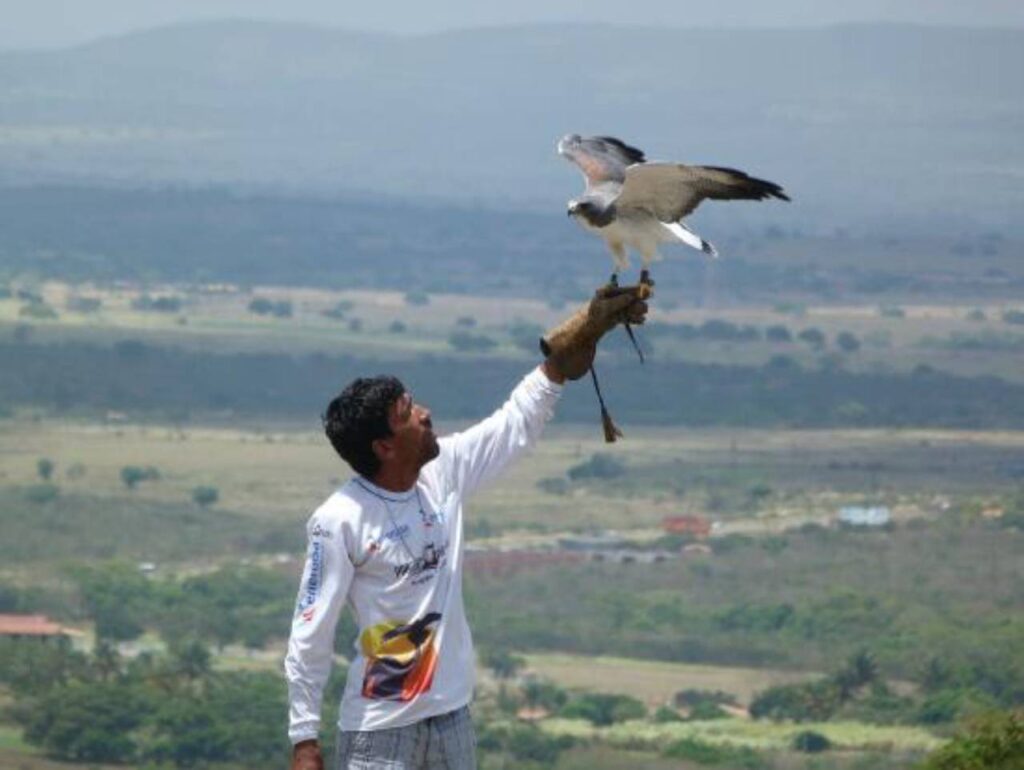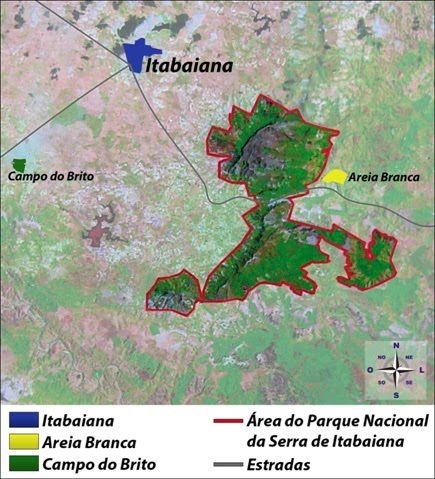Parque dos Falcões and Serra de Itabaiana are two unmissable ecotourism destinations in Sergipe, offering a rich experience of contact with nature and environmental learning. Here are details about each of these destinations and practical tips for visiting them.
1. Falcon Park in Sergipe

Parque dos Falcões is a conservation and rehabilitation centre for birds of prey, located in the municipality of Itabaiana, Sergipe. It is known for its conservation and environmental education work with falcons, owls, hawks and other birds of prey.

1. Main Attractions and Activities
1.1 Birds of Prey Exhibition
The park is home to several species of birds of prey, allowing visitors to observe them up close and learn about their characteristics and behaviour.
1.2 Flight demonstrations
Flight demonstrations are one of the highlights of the park, where trainers show the birds’ skills in free flight, providing an impressive spectacle.
1.3 Environmental education
Lectures and educational programmes will be provided focusing on the importance of raptor conservation and the environment.
1.4 Bird rehabilitation
The park works to rehabilitate injured birds with the aim of releasing them back into the wild. Visitors can hear some of the stories of rescue and rehabilitation.

2. Visiting tips
2.1 Opening Hours
The park is generally open every day, but it’s a good idea to check the opening times and book your visit in advance.
2.2 How to get there
Parque dos Falcões is located about 45 kilometres from Aracaju, in the town of Itabaiana. Access is easy by car and there are signs along the way.
History of Parque dos Falcões
Located about 45 km from Aracaju, at the foot of the Serra de Itabaina-SE, Parque dos Falcões was created through the work and efforts of two dreamers, José Percílio and Alexandre Correia.
Alexandre became Percílio’s “accomplice” in 1999, but the story of the Institute began in its founder’s childhood. At the age of 7, Percílio was given a Carcará (Caracara plancus) egg and after 28 days, hatched by a hen, Tito, his first great friend, was born. Today Tito is 27 years old and the Institute takes care of more than 300 birds, including hawks, falcons, owls, bullfinches, pigeons, etc.
Well known by many tourists, students, biologists, Brazilian and foreign researchers, the Institute is one of the few places in the country authorised by IBAMA to breed these birds in captivity.
With the aim of protecting the species of birds of prey that inhabit the Brazilian sky, the Parque dos Falcões has become a world reference in the management, reproduction and rehabilitation of these animals, accumulating a wealth of knowledge about their behaviour.
2. Itabaiana Mountain Range

The Serra de Itabaiana is an environmental reserve located in the municipality of Itabaiana, Sergipe. It is one of the main natural tourist attractions of the state, offering various outdoor activities and a rich biodiversity.
Another attraction in the city is the Serra de Itabaiana National Park, which combines the Atlantic Forest and Caatinga ecosystems, as well as being a rich water reserve with waterfalls that favour ecotourism.
The Serra de Itabaiana Park covers an area of 7,966 hectares and is managed by the Chico Mendes Institute for Biodiversity Conservation (ICMBio).
The mountain range offers more than 12 different trails, passing rivers, waterfalls, natural pools and cliffs. Its area includes: Poço das Moças, Via Sacra, Grotto da Serra, Caldeirão and the famous Falcon Park.
1. Main attractions and activities
1.1 Trails and walks
The mountain range has several trails, from the easiest to the most challenging. The Caldeirão Trail and the Gruta da Serra Trail are among the most popular.
1.2 Waterfalls and Fountains
The Serra de Itabaiana is rich in waterfalls and crystal clear pools, such as Cachoeira do Caldeirão and Poço das Moças, ideal for a refreshing dip.
1.3 Natural viewpoints
There are several viewpoints in the mountains that offer spectacular panoramic views. Mirante do Cruzeiro is particularly popular.
1.4. Bird and wildlife watching
The region is excellent for bird and wildlife watching, with several endemic and migratory species, as well as small mammals and reptiles.
2. Tips for visiting
2.1 Best time to visit
The best time to visit is during the dry season, from April to October, when the trails are less slippery and the climate is milder.
2.2 Local guides
Hiring a local guide is highly recommended, especially if you are unfamiliar with the trails. Experienced guides can provide a safer and more rewarding experience.
2.3 Equipment required
Wear comfortable walking shoes, light clothing, a hat, sunscreen and insect repellent. Bring water, snacks and bags for your rubbish.
2.4 How to get there
Serra de Itabaiana is about 60 kilometres from Aracaju and can be reached by road. It is possible to get there by private car or on an organised excursion.
How to combine visits
Combine a visit to Parque dos Falcões with a day of hiking in the Serra de Itabaiana for a complete experience. Start the day in the park, taking advantage of the flight demonstrations and educational talks, and then head up into the mountains to explore the trails and waterfalls.
A visit to Parque dos Falcões and Serra de Itabaiana offers a perfect combination of learning, adventure and contact with nature, providing an enriching and unforgettable experience.
Publicações Relacionadas
Pacatuba SE: The Gateway to the Sergipano Pantanal
Xingó Canyon: A Natural Wonder of Brazil
Sergipe has natural beauty and history - Tourist Spots
Ponta dos Mangues Beach: A Hidden Gem in Sergipe
Saco Beach is an option for those seeking tranquility in Sergipe
Beaches of Sergipe's Southern Coast You Must Visit
Santa Luzia Island's Best Attractions and Activities
Croa do Goré Island: Perfect Spot for Swimming
Pirambu is a fishing center of the Northeast and also has beautiful beaches
This post is also on:
![]() Português
Português ![]() English
English ![]() Deutsch
Deutsch ![]() Español
Español ![]() Français
Français




















